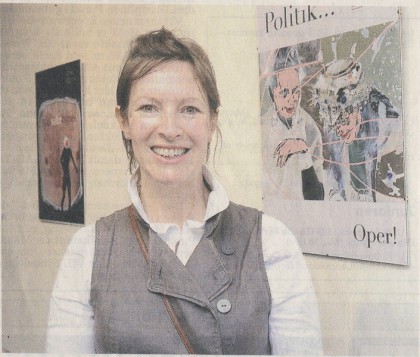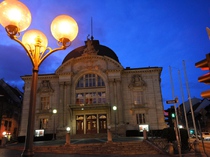ARCHIVE 2012
Artworks
Ingrid Christie
Press Archive
Fürther Nachrichten, 23.05.2012, CLAUDIA WUNDER
Eine atemberaubende Bildsprache
Ingrid Christie hat das Leben aus der Perspektive des Theaters beleuchtet
 Ingrid Christie vor zwei Arbeiten ihrer Plakatserie im Theaterfoyer. Hier zeigt sie sich als Meisterin der grotesken Collage. Foto: Hans-Joachim Winckler
Ingrid Christie vor zwei Arbeiten ihrer Plakatserie im Theaterfoyer. Hier zeigt sie sich als Meisterin der grotesken Collage. Foto: Hans-Joachim Winckler
Welcher Titel könnte besser zu einer Ausstellung im Stadttheater passen als „Theatrical Realities“? Keiner – zumal wenn der Bezug zum Haus auch noch so konkret ist, wie bei den Plakat-Collagen der Engländerin Ingrid Christie.
Es ist der unkontrollierte Moment des Zufalls, den sich Ingrid Christie für ihre Arbeiten zu Eigen gemacht hat. Denn Basis für ihre Plakat-Serie sind von ihr zufällig ausgewählte Veranstaltungen aus dem Spielplan 2011. Deren Aufführungsdatum musste eine Primzahl sein, also beispielsweise der 23.7. oder der 7.3..
Christie machte sich mit den Inhalten der Schauspiele und Konzerte vertraut und stellte sie in eine Wechselbeziehung zu einer – nun bewusst getroffenen – Auswahl an Geschehnissen in der Weltpresse, die sich an den jeweiligen Tagen ereignet hatten. Auf diese Weise verknüpft die Künstlerin motivisch die Ereignisse, die zwar gleichzeitig, aber ohne Bezug und inhaltliche Bindung zueinander stattfanden, zu einer bildkünstlerischen Form. Ingrid Christie, die ihr Kunststudium an der Universität von Central Lancashire mit Auszeichnung absolvierte, gilt als virtuose Collagistin. Ihr Handwerkzeug ist, abseits aller digitalen Möglichkeiten, die Schere. Wollte man eine historische Bezugsgröße finden, käme wohl die Dadaistin Hannah Höch in den Sinn, die durch ihre geschnittenen und geklebten Werke internationalen Ruhm erfahren hat. Auch sie zielte auf Verstörung ab, forderte, wie auch Christie, den Betrachter auf, unverstellt und umfassend auf das zu schauen, was ist, auch wenn es schmerzhaft sein sollte.
So nutzt Ingrid Christie etwa die Aufführung des Opernspaßes „Blau an der schönen Donau“ vom 5.3.11 zu einem Querschläger auf die Real-Groteske um den italienischen Ministerpräsidenten Silvio Berlusconi. Oder der absurde Totentanz „Das große Massakerspiel“ von Eugène Ionesco, aufgeführt am 17.7.11. jede Szene endet hier im Sterben – und die Künstlerin fand hier einen passenden Bezug im Finale der Fußballweltmeisterschaft der Frauen. Hier wie dort ein Spiel. Hier wie dort Ernst.
Der Sieg der Japanerinnen im Elfmeterschießen – angesichts der atomaren Katastrophe in Fukushima Balsam auf die Seele des Landes – kam den Topfavoriten, den Amerikanerinnen, wie ein kleiner Tod vor. Christie transformiert dies in eine aufregende Bildsprache: Die Umrisse einer eher kantigen Weiblichkeit sind vor dem Foto einer männlichen Brust positioniert, die v6n einer Art wuchernden Ekzem befallen ist, anstatt des Kopfes thront ein Fußball in den Nationalfarben Japans auf dem Kopf der stilisierten Frau.
What title could better match an exhibition in the Stadttheater than "Theatrical Realities"? None - especially when the connection is so specific, aswith the poster collages by Ingrid Christie from England.
It is the uncontrolled moment of coincidence that Ingrid Christie has adapted for her own work. The basis of her poster series is a random selection of events from the 2011 list of plays, with the day of their performance being a prime number, for example, the 23.7. or 7.3..
Fürther Nachrichten, 23.05.2012, CLAUDIA WUNDER
A breathtaking visual language
Ingrid Christie spotlights life seen through the theatre perspective
Christie made herself familiar with the contents of the plays and concerts and put them into relationship with – (now specifically chosen) – a selection of events in the world press which had occurred on the respective days. In this way the artist links motivically the events which, while simultaneously, took place but without reference and content-bond to each other, into a visual artistic mold. Ingrid Christie, who completed her art studies at the University of Central Lancashire with distinction, is considered a virtuoso collagist. her main tool is with all digital possibilities aside, the scissors. If one wanted to find an historical comparison then probably the Dadaist Hannah Höch comes to mind, who earned international fame through her cut and glue works. She also aimed to distract, and as Christie called on the viewer to look genuinely and comprehensively at what is real, even if it’s painful.
Thus Ingrid Christie uses the performance of the fun opera "blue (tipsy) on the beautiful Danube" from 05.03.11 as a bullet hit at the real-grotesque about the Italian Prime Minister Silvio Berlusconi. Or the absurd dance of death "The great massacre game" by Eugene Ionesco, performed on 07.17.11.. Each scene ends here as a death - and here the artist found a suitable reference in the final of the FIFA World Women's Championship. Here and there a game. Here and there serious.
The victory of Japanese women footballers on penalties - in the face of the nuclear disaster in Fukushima balm for the soul of the country – seemed to the top favorites, the Americans, like a quick death. Christie transformed it into exciting visual language: Outlined in a more edgy femininity with a male breast that is infected with a kind of rampant eczema positioned in front of the photograph, instead of the head a soccer ball sits in the national colours of Japan at the head of the stylised woman.
























